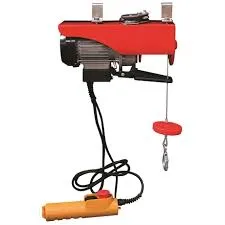


Understanding Rigging, Chain Blocks, and Their Applications
In the realm of lifting and moving heavy loads, rigging plays a crucial role in ensuring that operations are safe and efficient. Among the various equipment used in rigging, chain blocks stand out as essential tools for lifting and lowering heavy materials. This article will explore the intricacies of rigging and chain blocks, their operational principles, and their applications in various industries.
What is Rigging?
Rigging refers to the system and equipment used to lift, move, or secure loads. It encompasses a wide range of tools, including slings, shackles, hoists, and winches. The primary aim of rigging is to ensure that loads are lifted safely and securely, minimizing the risk of accidents and injuries. Proper rigging techniques are vital in construction sites, factories, and shipping yards where heavy machinery and materials are handled regularly.
Chain Blocks A Key Component of Rigging
Chain blocks, also known as chain hoists, are mechanical devices designed to lift heavy loads vertically. At their core, they consist of a durable chain, a lifting mechanism (usually a ratchet or gear system), and hooks or other attachments for securing the load. The user pulls the chain, which activates the lifting mechanism, allowing the block to raise or lower the load with minimal effort.
Chain blocks are favored for their simplicity and effectiveness. They can lift substantial weights, often ranging from hundreds to several tons, making them ideal for various tasks, from construction to shipping. Moreover, they are typically portable and can be used in various locations, further adding to their versatility in lifting operations.
Benefits of Using Chain Blocks in Rigging
1. Efficiency Chain blocks can significantly reduce the physical effort required to lift heavy loads. By utilizing mechanical advantage, they allow operators to handle more weight than they could manage manually.
2. Control Chain blocks offer precise control over the lifting and lowering of loads. This is especially important when working in confined spaces where precise positioning is necessary.

3. Durability Made from high-quality materials, chain blocks are built to withstand harsh working conditions and heavy usage, ensuring longevity and reliability.
4. Safety With proper training and usage, chain blocks can be operated safely, thereby reducing the risk of accidents. They are equipped with features such as overload protection and safety latches, which further enhance their safety profile.
Applications of Chain Blocks
The use of chain blocks extends across various industries, reflecting their versatility.
- Construction Chain blocks are commonly used to lift structural components, such as beams and heavy machinery. They help in positioning loads accurately and safely, which is critical in construction operations.
- Manufacturing In factories, chain blocks facilitate the assembly of large equipment and machinery, enabling workers to lift heavy parts without straining themselves.
- Transport and Shipping In shipping yards and warehouses, chain blocks are vital for loading and unloading goods. They aid in moving heavy shipments efficiently and securely.
- Maintenance and Repair Chain blocks are also employed in maintenance tasks, such as lifting engines or heavy equipment for repair in garages and workshops.
Conclusion
Understanding the principles of rigging and the functionality of chain blocks is essential for anyone involved in industries requiring heavy lifting. Their efficiency, control, durability, and safety features make chain blocks indispensable tools in various applications. As heavy lifting operations continue to evolve, so will the technology and techniques surrounding rigging and chain blocks. Proper training and adherence to safety standards are fundamental in maximizing the benefits these tools offer while minimizing risks in the workplace. Investing in quality rigging equipment is not just a choice but a necessity for operational excellence and safety in any heavy-duty environment.



